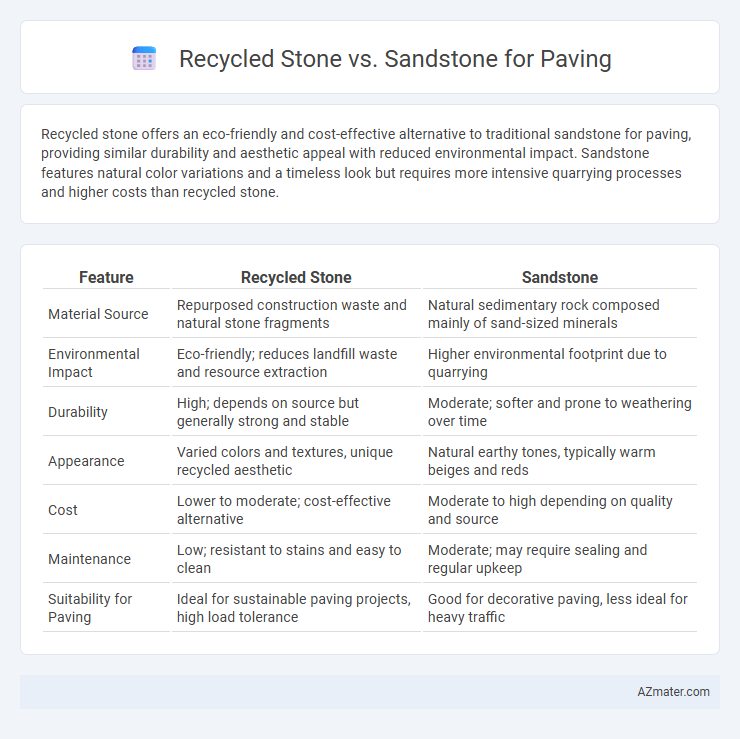Recycled stone offers an eco-friendly and cost-effective alternative to traditional sandstone for paving, providing similar durability and aesthetic appeal with reduced environmental impact. Sandstone features natural color variations and a timeless look but requires more intensive quarrying processes and higher costs than recycled stone.
Table of Comparison
| Feature | Recycled Stone | Sandstone |
|---|---|---|
| Material Source | Repurposed construction waste and natural stone fragments | Natural sedimentary rock composed mainly of sand-sized minerals |
| Environmental Impact | Eco-friendly; reduces landfill waste and resource extraction | Higher environmental footprint due to quarrying |
| Durability | High; depends on source but generally strong and stable | Moderate; softer and prone to weathering over time |
| Appearance | Varied colors and textures, unique recycled aesthetic | Natural earthy tones, typically warm beiges and reds |
| Cost | Lower to moderate; cost-effective alternative | Moderate to high depending on quality and source |
| Maintenance | Low; resistant to stains and easy to clean | Moderate; may require sealing and regular upkeep |
| Suitability for Paving | Ideal for sustainable paving projects, high load tolerance | Good for decorative paving, less ideal for heavy traffic |
Introduction to Paving Material Choices
Recycled stone offers an eco-friendly paving option by repurposing quarry waste and demolished concrete, reducing landfill impact while providing durability and cost-effectiveness. Sandstone, a natural sedimentary rock, is prized for its aesthetic appeal, natural texture, and long-lasting strength in paving applications. Choosing between recycled stone and sandstone depends on factors such as budget, environmental priorities, desired appearance, and maintenance requirements.
What is Recycled Stone?
Recycled stone for paving consists of crushed concrete, bricks, or natural stone materials repurposed from demolition waste, offering an eco-friendly and cost-effective alternative to traditional sandstone. This sustainable material combines durability and unique texture, providing excellent drainage and reducing landfill impact compared to quarried sandstone. Recycled stone's versatility and lower environmental footprint make it a preferred choice for paving in green construction projects.
Understanding Sandstone Paving
Sandstone paving offers natural durability and an attractive range of earthy hues, making it a popular choice for outdoor surfaces. Its porous structure enhances slip resistance while allowing for effective drainage, ideal for patios and walkways. Compared to recycled stone, sandstone requires periodic sealing to maintain its appearance and prevent staining in high-traffic areas.
Environmental Impact: Recycled Stone vs Sandstone
Recycled stone offers a significantly lower environmental impact than traditional sandstone by reducing quarrying activities and minimizing natural resource depletion. Its production often involves repurposing demolition waste, which lowers landfill contributions and energy consumption. Sandstone extraction typically results in habitat disruption and higher carbon emissions due to intensive mining processes.
Durability and Longevity Comparison
Recycled stone offers enhanced durability and longevity due to its compressed, engineered composition that resists cracking and weathering better than natural sandstone. Sandstone, while aesthetically appealing and naturally textured, tends to be softer and more porous, making it more susceptible to erosion and wear over time. For long-term paving projects, recycled stone provides superior resilience against heavy foot traffic and environmental factors, resulting in a longer lifespan and reduced maintenance costs compared to sandstone.
Aesthetic Appeal and Design Flexibility
Recycled stone offers a unique aesthetic appeal with its varied textures and colors derived from reclaimed materials, creating a rustic and environmentally friendly look for paving projects. Sandstone provides a classic, natural beauty with its warm hues and smooth surface, allowing for versatile design patterns and finishes suitable for both traditional and contemporary landscapes. Both materials enhance design flexibility, but recycled stone excels in creating distinctive, eco-conscious layouts, while sandstone supports more uniform and polished appearances.
Installation Process and Ease of Use
Recycled stone offers greater ease of installation due to its irregular shapes that naturally interlock, reducing the need for precise cutting and fitting compared to sandstone. Sandstone requires more careful preparation and cutting to achieve a uniform look, which can extend the installation time and demand skilled labor. Both materials benefit from proper base preparation, but recycled stone's variability often makes it more forgiving during paving projects.
Cost Analysis: Budget Considerations
Recycled stone offers a cost-effective alternative to sandstone for paving, often reducing material expenses by up to 40% due to lower extraction and processing costs. Sandstone typically commands higher prices due to quarrying, transportation, and finishing processes, which can significantly impact project budgets. When prioritizing budget considerations, recycled stone provides substantial savings without compromising durability or aesthetic appeal.
Maintenance Requirements and Lifespan
Recycled stone paving requires minimal maintenance due to its durable composition and resistance to weathering, often lasting over 25 years with proper care. Sandstone, while aesthetically pleasing, demands regular sealing and cleaning to prevent erosion and staining, with an average lifespan of 15 to 20 years. Choosing recycled stone reduces long-term upkeep costs and extends paving longevity compared to sandstone.
Choosing the Right Material for Your Project
Recycled stone offers an eco-friendly and cost-effective option for paving, featuring durability and a unique aesthetic that complements sustainable landscaping projects. Sandstone provides natural beauty with its warm hues and smooth texture, ideal for creating elegant, traditional walkways and patios. Selecting the right material depends on factors like budget, environmental impact, desired appearance, and longevity requirements for your paving project.

Infographic: Recycled stone vs Sandstone for Paving
 azmater.com
azmater.com